The legendary Thruxton name is back, in a package that’s one-third of what it once was ensconced in. So… is this new thing worthy of that moniker?
Photography by Sanjay Raikar

There’re few motorcycle classes with a history as rich and illustrious as the café racer. And in the world of café racers, there’s one name that stands head and shoulders above all–the one that spawned this whole category in fact, the Thruxton.
By lending this new thing a name like that that carries such serious heritage baggage, it’s clear Triumph sees this model as more than just the fifth entry to its wildly popular 400-cc lineup. On paper, the Thruxton 400 promises a focused, rider-first experience, chasing the DNA of the legendary café racers of the sixties rather than merely copying their looks.
I spent a day with the bike, on city rides, sweeping hill stretches, filtering through narrow side roads, to see how well the Thruxton 400 holds up to both its marketing claims and legacy. Here’s what stood out, and what didn’t.

The Thruxton 400’s styling is deliberate, assertively retro, with nods to the café racers Triumph has built its modern classic reputation on. To be honest, it visually resembles the Speed Triple 1200 RR a lot more than it does the last Thruxton 1200, but that’s perfectly fine as I actually prefer the cleaner, sleeker looks of the former. The sleek half fairing, clip-ons, swan neck risers and translucent front brake reservoir serve their purpose, signaling that you’re dealing with a bike that wants to be noticed. Its overall proportions and cues—Monza fuel cap, bar-end mirrors, and clean-cut tank accents—track closely with Triumph’s larger, more expensive models, which, to their credit, show up with rarely any visible ‘budget’ compromises.
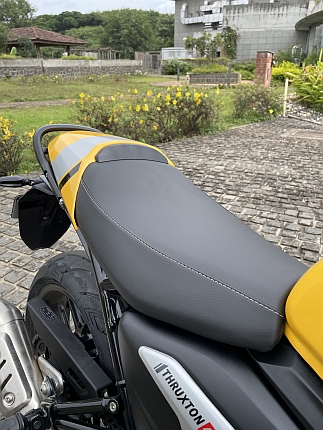
For such a bold motorcycle, then, we were left a bit unimpressed with just how safe Triumph had chosen to play when it came to the posterior. The café racer de rigueur seat cowl (removable via two allen screws) seems like an afterthought, not something that was part of the overall design from the start, and we don’t think too many of the Thruxton 400’s potential customers would’ve decried the lack of a pillion grab rail.
Fit and finish are, largely, as you’d expect from Triumph: the tank welds are concealed, panel gaps are tight, and the painted finishes have sufficient depth. Four available colour schemes—Lava Red, Pearl White, Phantom Black, and Racing Yellow—cater to various aesthetic preferences. We were allotted the Racing Yellow, the loudest of the four, and, coupled with the fact that we were riding a never-before-seen motorcycle with red number plates, the attention we received everywhere was nothing short of a Dutch tourist in an Indian village. If I had to pick one colour for myself, it’d be the Pearl White, a tasteful and yet uncommon shade that quietly accentuates the lines of the bike without screaming it out.
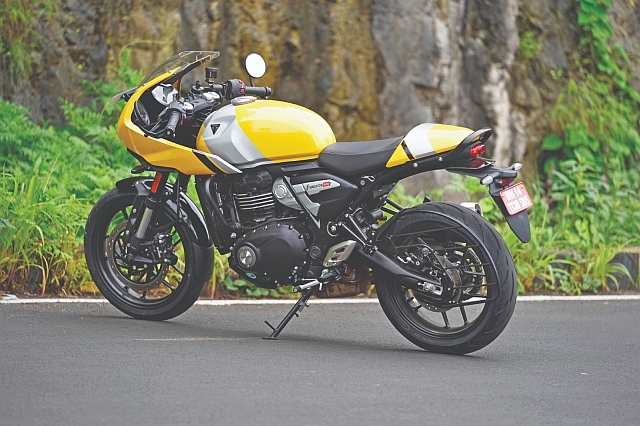
Cast 17-inch wheels avoid any faux-vintage wire-spoke pretensions. They’re light, practical, and shod with Apollo Alpha H1 tyres that suit both city and highway use. There isn’t much that feels flimsy; the Speed 400’s switchgear still operates with a reasonable sense of quality, if not quite matching the premium hardware of Triumph’s higher-end range.
Don’t expect gadget overload like a sportbike here. The Thruxton 400’s feature set is utilitarian. Switchable traction control and ABS are included, and the existing braking hardware – with a four-piston radial caliper up front and a single-piston rear, gripping sintered brake pads – is fundamentally solid.
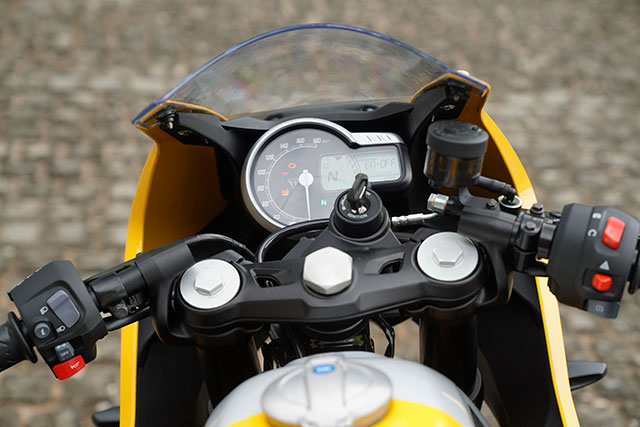
While the existing analog speedo and inlaid LCD display are easy to read and provide all essential info, we wish Triumph had stuck to the café-racer aesthetic and given us a proper old-school twin-pod instrument console – perhaps with a digital inset in between as a concession to modern-day requirements. There’s a handy USB charger, but no keyless start, no riding modes, nor any particularly advanced telemetry, though honestly, none are essential for what is positioned as a pared-back, enthusiast’s offering.
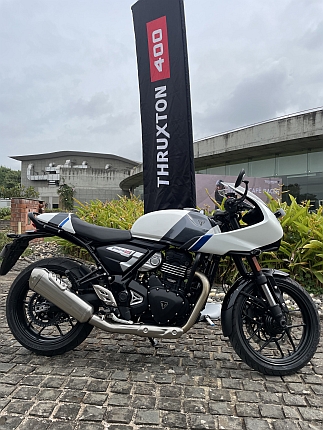
Triumph is also offering some accessories for the Thruxton R, like a minimalist engine guard that protects your engine in case of a fall, without ruining the aesthetics of this sleek machine in repose. There’s also a quilted seat, round LED indicators, tank pads, and even a tail bag for those brave enough to go touring on what is still very much a café racer.
This is only the second time that I had experienced bar-end mirrors on a motorcycle, and to my pleasant surprise, the visibility here is pretty reasonable–you can see a lot more of the traffic here rather than just admiring your triceps and lats through your jacket.
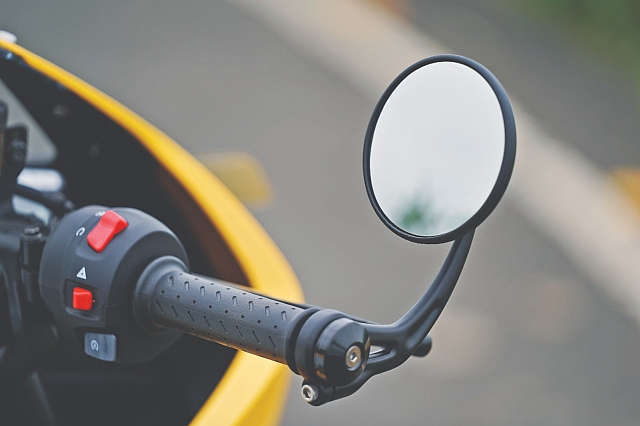
The Thruxton 400 is constructed for rider engagement and its ergonomics reflect that fully. Its lower seat, narrow clip-ons, and higher and more rear-set pegs create an unambiguously sporty posture. Despite being roomy enough, this is not an all-day touring setup, but that’s not why anyone would be considering this machine.
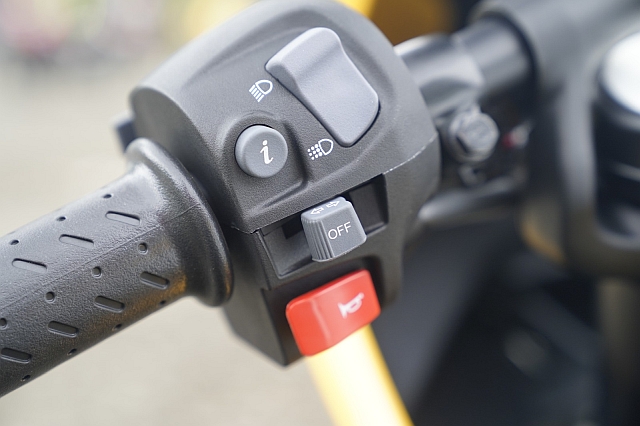
Its longer tank effectively locks the knees, letting the rider grip it under acceleration and braking, but the sustained lean forward can be fatiguing, particularly in slow-moving traffic or during long stints. In return, though, the sense of control and connection you get while cornering or braking is hard to ignore.
Triumph has eked out a genuine 42 hp (an increase of two hp) from its single-cylinder TR Series 400 engine, with the same old 37.5 Nm now delivered 1,000 rpm higher at 7,500 rpm, aided by higher-revving cam timing. They also took two teeth off the rear sprocket to make the gearing taller and endow the Thruxton 400 with that magical number that café racers have forever been associated with: 100 mph. That, in our lingo, translates to a top speed of 161 km/h. So yes, it is still a café-racer, albeit with a smaller heart.

It isn’t just straight-line speed, though. In almost every parameter, the newest member of the family is faster than the Speed 400… 0–60km/h in under three seconds, 0–100 in 6.7 s, and a redline that’s higher by 1,000 rpm. Part of that liveliness is also because of the low gearing and the solid shove available from middling rpm upwards. Power delivery is sensible—linear, with no giddy or abrupt surges—and the refinement is remarkably subdued for what is, after all, a single.
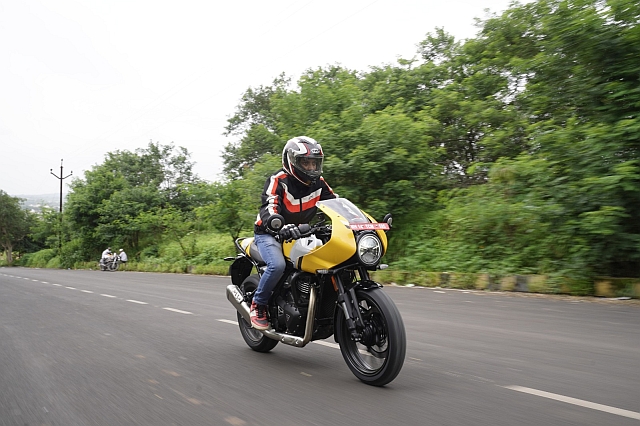
Gear changes are precise enough, but not buttery-smooth; the six-speed box ratios suit both city and highway use equally well but will rarely have you chasing for a different cog. The slip-assist clutch is a practical touch in stop-start conditions, but doesn’t stand out as being significantly lighter than the segment average. At a steady highway cruise, the engine sits under 7,000 rpm in top gear, which is tolerable. Triumph claims a fuel efficiency figure of 27.5 km/l, a mere 1 km/l drop from the numbers of the Speed 400. For the added thrill and poke on offer here, we think that’s a reasonable compromise.
Heat management holds up even in crawling traffic, thanks to the revised radiator shroud. Idle stability and start-up are both fuss-free, at least on our mint condition machine.
Suspension was one area where I expected big compromises, but the Thruxton 400 manages to walk the fine line between city compliance and sportier road manners. The re-tuned 43mm Big Piston USD fork and monoshock provide 10mm more travel than Triumph’s Speed 400, and also have been stiffened up to compensate for the five-odd-kilo increase in weight and the bike’s more focused intentions.
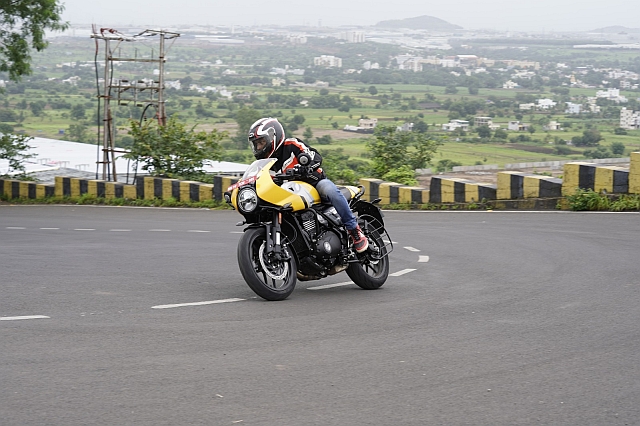
Ride quality is generally composed, though never plush. The chassis feels stiff, so sharp bumps occasionally translate through the seat and bars, but low-speed damping blunts most urban potholes well. The bike never feels wallowy or floaty, holding its line on uneven highways, and the rear suspension doesn’t bottom out unless provoked by severe impacts. Yes, we inadvertently tested that too. Thanks Pune Municipality.
Where the Thruxton 400 bests much of its competition is in chassis dynamics. The tightened rake (24.5 degrees) and 10mm shorter wheelbase lend it a direct, eager steering feel. Flicking through city traffic, it feels compact, holds a line where it’s pointed, and doesn’t require effort to tip into bends.
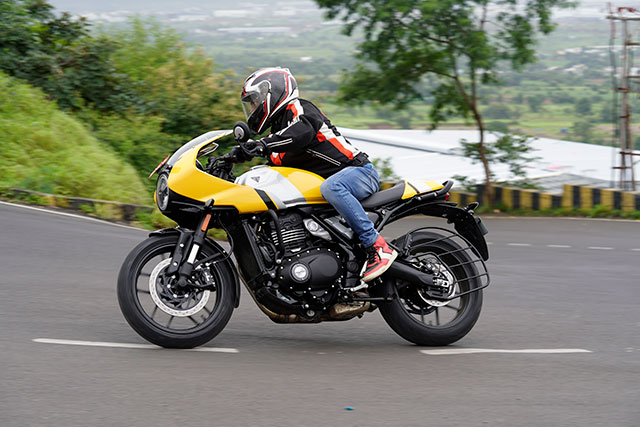
By default, it comes with Apollo Alpha H1 tyres, measuring 110/70 at the front and 150/60 at the rear, though MRF tyres (we aren’t sure of the exact model) are also an option. The Alpha H1 tyres have already proven their worth on multiple other motorcycles, so much so that they have become the default choice for sport bikers seeking a replacement for their OEM tyres, and they don’t disappoint in the least with this new setup. We rode through a wide variety of surfaces including some fast switchbacks and even did some stretches of quick acceleration and deceleration for the camera, and they remained grippy, responsive and always confidence-ensuring.
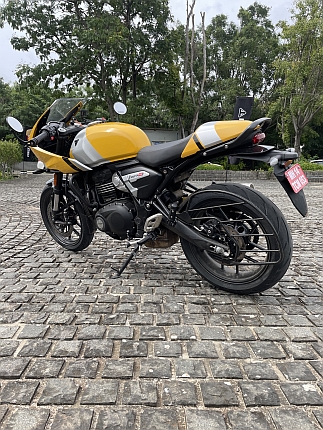
At moderate to brisk speeds, the added front-end sharpness is rewarding, imparting confidence on smoother, winding roads. The aggressive, engaged riding triangle eagerly supports quick direction changes, but those same ergonomics can begin to tire you sooner than on upright alternatives like, say, the Speed 400.
Braking, handled by the same hardware as the one on the Speed 400 UG, sometimes lacks the outright bite or feedback of the best in the class, especially at the rear lever. For regular riding, it’s more than adequate, and the bike always stops with composure, but hard chargers may wish for an upgrade.
At highway speeds, the Thruxton 400’s stability is commendable. There’s none of the nervousness sometimes found in shorter bikes, and it tracks straight, even in sizably heavy crosswinds. Yes, we inadvertently tested that too. Thanks, August monsoons.
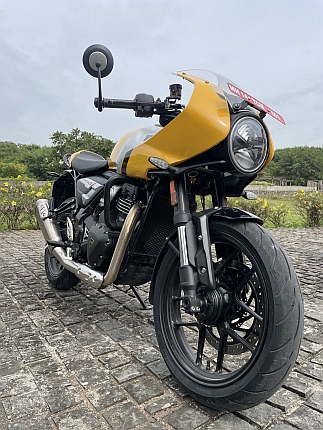
The Thruxton 400 is not built for broad appeal. This is a focused, deliberately uncompromising café racer intended for enthusiasts who value dynamic handling and distinctive styling over everyday utility or comfort. Triumph’s reputation for engineering quality is mostly upheld, with a few caveats in terms of practicality and ergonomics that will only suit a certain subset of riders.
For Rs 2.74 lakh, ex-showroom, you get a fully featured, visually appealing bike with reasonable service intervals and build quality. But, it doesn’t deliver remarkable value if your priorities are comfort or technology; the Thruxton 400 is about engagement first, and everything else second.
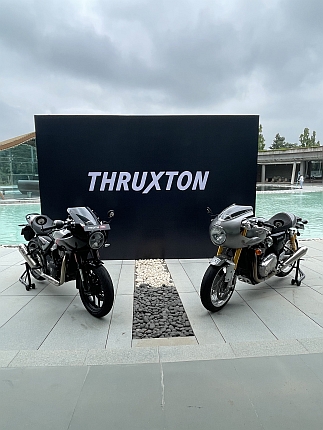
There’s really only a handful of meaningful alternatives. The Royal Enfield Continental GT 650 offers more displacement and two cylinders, but it’s heavier, considerably more expensive, and less accessible for beginners. Triumph’s own Speed 400 is more upright and commuter-friendly, while the KTM 390 Duke and Honda CB300R offer their own spins on sportiness, the former with far more aggression, the latter with simplicity and ease of use.
As it stands, the Thruxton 400 is a tightly focused entry to Triumph’s modern classic family. For the right buyer—one who values raw performance and agile handling more than outright comfort or utility—it’s close to peerless at this price. For others, including those new to committed riding positions or regularly carrying a pillion, there are better options that exchange some engagement for increased practicality. The Thruxton 400 sticks to its brief and, in doing so, limits its audience—but for that core audience, it will be the most grin-inducing investment they’ll have made for a long long time.

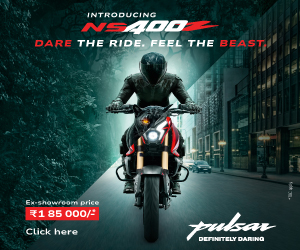
Leave a Reply